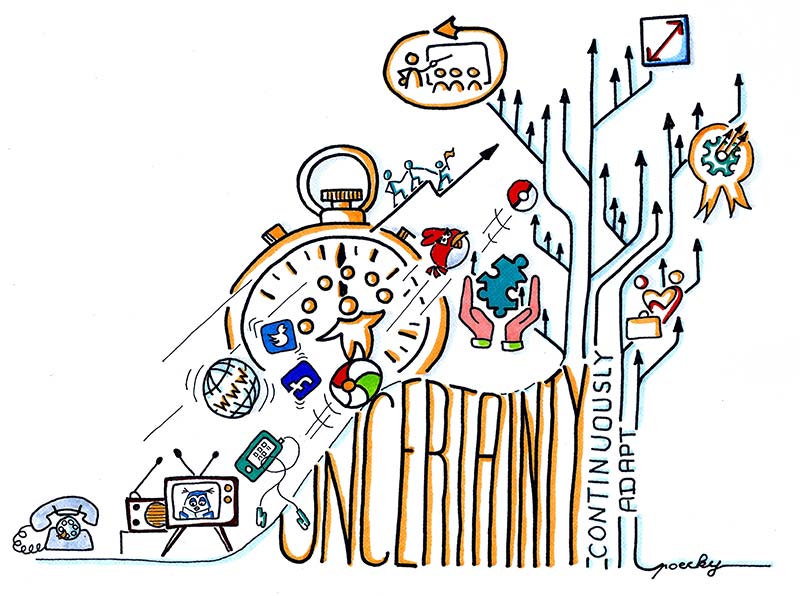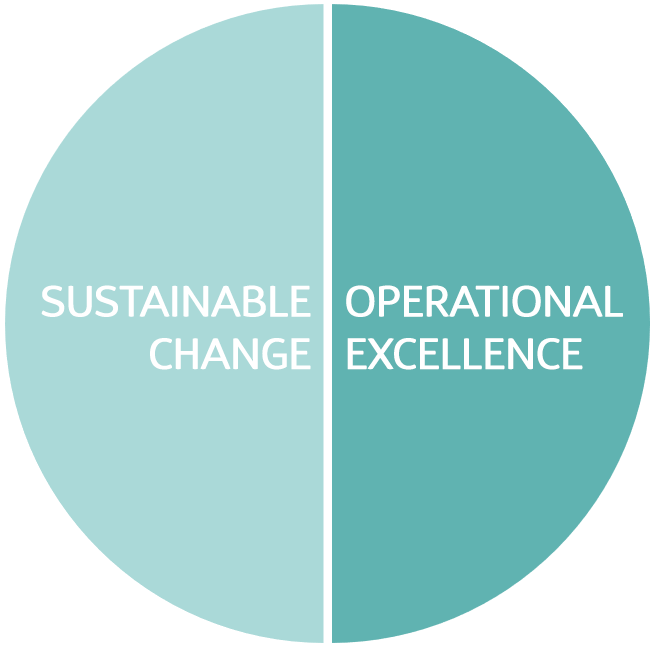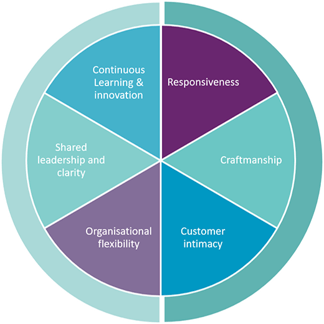On the eve of 2020, the world is in full expansion. We want things to be faster, better and more personalized. All over the globe, companies are looking for ways to be successful in the face of increasing demand-driven complexity. Many of them turn to agile transformation processes to make their businesses more futureproof. But are those really the key to victory?

Agile transformation is by no means a guarantee of sustainable results. In a recent McKinsey research study, just 26 percent of the business leaders surveyed said their transformations had led to increased performance and a lasting outcome. In short, three out of four transformations fail to achieve their long-term goals. What contributes to this trend, and how can you ensure that your efforts do succeed?
Not sure just where to start your agile approach? Discover the 3 principles of sustainable agility for inspiration.
The question that nobody asks
‘To measure is to know’: it’s a phrase we’ve all heard. But this is precisely the sticking point. Many years of experience with agile transformations have taught us that in the vast majority of cases, there is no clear link between what is measured and the (business) objectives of the transformation.
Of course, businesses do report on the progress of the transformation: the number of teams coached or personnel trained, the extent to which teams apply certain practices, etc. Yet, that’s about it. They rarely question whether the adoption of a new, agile organizational model automatically generates progress towards business objectives. Even more, agility is not a cure-all leading to the achievement of every strategic goal. It is quite possible that improved agility can only contribute to a limited number of your business objectives.
Your goals as your compass
At Cegeka, specialized in agile transformations, we work differently. From the very start of your project, we focus on accomplishing your organizational goals without dogmatic dedication to methods, techniques or organizational models. Each project begins with the setup of a ‘compass’, a set of indicative targets to be achieved within a defined period. We link metrics to each of these objectives in order to monitor the effects of our coaching impulses in a transparent manner and adjust the coaching process if necessary.
Six capabilities determine whether you’re future-proof
But which organizational objectives are the ‘right’ ones? What makes one organization better prepared for future challenges than another? From experience, we know that there are six capabilities that determine whether an organization is ready for the future. We use capabilities as a starting point when determining your organizational objectives.


Operational excellence: be good at what you do
The first three capabilities – responsiveness, customer intimacy and craftmanship – can be summarized under the heading of operational excellence:
|
Responsiveness |
Customer intimacy |
Craftmanship |
|---|---|---|
|
Speed is crucial in today’s business world. More than ever, customers expect instant solutions. |
A quick delivery is one thing, but does the outcome satisfy customer expectations? To ensure this, involve your customers in the process. |
The rapid and sustainable delivery of high-quality products can only be achieved by working in an equally qualitative manner. |
|
Ask yourself questions like:
|
Examine, among others:
|
Questions include:
|
Responsiveness
Speed is crucial in today’s business world. More than ever, customers expect instant solutions.
Ask yourself questions like:
- How long does it take to convert customer demands into a working product?
- How much time do you need to identify and correct errors in the production process?
Customer intimacy
A quick delivery is one thing, but does the outcome satisfy customer expectations? To ensure this, involve your customers in the process.
Examine, among others:
- Does the organization possess the right business knowledge and expertise?
- How frequently is the approach coordinated with real end users?
- Are you really resolving the client’s issues?
Technical excellence
The rapid and sustainable delivery of high-quality products can only be achieved by working in an equally qualitative manner.
Questions include:
- What measures have been taken to guarantee a superior product?
- How often do errors occur in the production chain?
- Are expertise and experiences being shared sufficiently?
Many transformation processes focus on these objectives. They consider the transformation completed when the organization has adapted itself to the new ‘target operating model’. Yet, they quickly discover that the new organizational form does not make them fully future-proof. They respond by setting up new transformation processes only to see that the results are again short-lived. The main culprit? Failure to adapt to change. In order to respond quickly in a dynamic context, organizations must integrate change into their daily operations in a sustainable way.
Sustainable change: the chameleon effect
The most successful businesses have the capacity to continuously adapt to new and constantly changing situations. This is what we call sustainable change. It comprises three capabilities: organizational flexibility, continuous learning and innovation and shared leadership.
|
Organizational flexibility |
Continuous learning and innovation |
Shared leadership and clarity |
|---|---|---|
|
You can organize your business in such a way that it can be highly responsive to customer questions. But what happens when you have to make changes that are not customer driven? Can you make it work just as easily? |
Close cooperation is vital to clearly understand customer needs. But there is more: it’s vital, today and tomorrow, to create the best products in an effective, high-quality manner. This requires nonstop focus on innovation. |
A flexible, agile and innovation-oriented company can only be achieved by allowing employees a certain degree of self-organization. This goes hand in hand with clarity and transparency. |
|
Examine, among others:
|
Questions include:
|
Ask yourself questions such as:
|
Organizational flexibility
You can organize your business in such a way that it can be highly responsive to customer questions. But what happens when you have to make changes that are not customer driven? Can you make it work just as easily?
Examine, among others:
- How quickly can you successfully set up or staff new teams?
- To what extent do silos exist in your company?
Continuous learning and innovation
Close cooperation is vital to clearly understand customer needs. But there is more: it’s vital, today and tomorrow, to create the best products in an effective, high-quality manner. This requires nonstop focus on innovation.
Questions include:
- Are new ideas welcome?
- Is there room to learn from your mistakes?
- How are new ideas converted into products, methods or services?
Shared leadership and clarity
A flexible, agile and innovation-oriented company can only be achieved by allowing employees a certain degree of self-organization. This goes hand in hand with clarity and transparency.
Ask yourself questions such as:
- Are the vision and mission clear for each team?
- Do managers trust their teams to make their own decisions?
- Are the boundaries on autonomy clear?
- Does the team have all the necessary information to make the right decisions?
From impulse to long-lasting results
How do you put this six-capability transformation process into practice? How can you strengthen these capabilities in your organization? This can only be achieved by establishing the right (combination of) impulses, such as awareness sessions, coaching interviews and workshops on very specific topics.
Over the years, we have developed an arsenal of impulses and tested them in various circumstances to constantly refine them. We regularly meet with the client to discuss the effect of the impulses that have been implemented and to consider which new impulses will be scheduled.
Our iterative and transparent way of working enables you to focus on what really matters: achieving lasting results that stand up to any environmental challenge. Get inspired and discover how Cegeka’s agile coaches turned the IT department of RSVZ into a modern organization.

